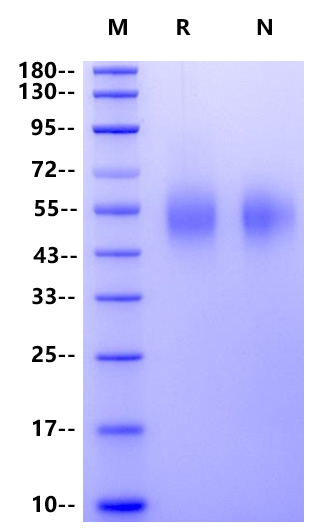Lys35-Gly320, with C-terminal 8*His KLTIESTPFNVAEGKEVLLLAHNLPQNRIGYSWYKGERVDGNSLIVGYVIGTQQATPGPAYSGRETIYPNASLLIQNVTQNDTGFYTLQVIKSDLVNEEATGQFHVYPELPKPSISSNNSNPVEDKDAVAFTCEPEVQNTTYLWWVNGQSLPVSPRLQLSNGNMTLTLLSVKRNDAGSYECEIQNPASANRSDPVTLNVLYGPDVPTISPSKANYRPGENLNLSCHAASNPPAQYSWFINGTFQQSTQELFIPNITVNNSGSYMCQAHNSATGLNRTTVTMITVSGGGGSHHHHHHHH
45-70kDa
>95% by SDS-PAGE
PBS, pH7.4
Reconstitute at 0.1-1 mg/ml according to the size in ultrapure water after rapid centrifugation.
· 12 months from date of receipt, lyophilized powder stored at -20 to -80℃.
· 3 months, -20 to -80℃ under sterile conditions after reconstitution.
· 1 week, 2 to 8℃ under sterile conditions after reconstitution.
· Please avoid repeated freeze-thaw cycles.
1、Duxbury M S. et al. (2004) Overexpression of CEACAM6 promotes insulin-like growth factor I-induced pancreatic adenocarcinoma cellular invasiveness. Oncogene. 23(34): 5834-5842.
2、Lewis-Wambi J S. et al. (2008) Overexpression of CEACAM6 promotes migration and invasion of oestrogen-deprived breast cancer cells. Eur J Cancer. 44(12): 1770-1779.
Carcinoembryonic antigen-related cell adhesion molecule 6 (non-specific cross reacting antigen) (CEACAM6) is also known as CD66c (Cluster of Differentiation 66c), CEAL, NCA, and is one of seven human CEACAM family members within the immunoglobulin superfamily. Human CEACAM-6 is a 90 kDa, GPI-linked membrane protein that contains a 34 amino acid (aa) signal sequence, a 286 aa extracellular domain (ECD), and a 24 aa hydrophobic C-terminal propeptide. CEACAM-6 contains one N-terminal V-type Ig-like domain (N domain), followed by two C2-type Ig-like domains. It shows considerable glycosylation, including (sialyl) LewisX, which mediates binding to E-selectin, galectins and some bacterial fimbrae. CEACAM family members are widely expressed in epithelial, endothelial, and hematopoietic cells, including neutrophils, T-cells, and NK cells. CEACAMs appear to be capable of transmitting signals that result in a variety of effects depending on the tissue, including tumor suppression, tumor promotion, angiogenesis, neutrophil activation, lymphocyte activation, regulation of the cell cycle, and regulation of adhesion. CEACAMs have now been associated with numerous intracellular signaling processes including cell adhesion, cell growth, recognition and differentiation, angiogenesis, and apoptosis.


Immobilized CEACAM-6/CD66c His Tag Protein, Human (Cat. No. UA010336) at 10μg/mL (100μL/well) can bind Biotinylated Human CD66b, His tag with EC50 of 16.56-27.32ng/mL.